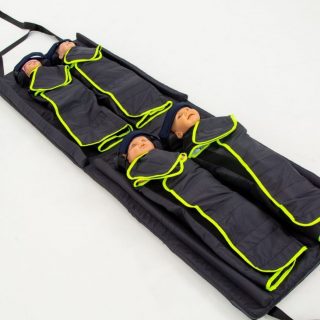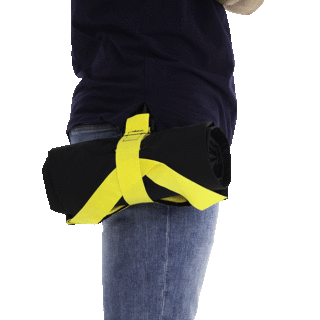Subtotal: $1,488.00
Welcome to Search Strategy for the Lost and Missing.
This intro lessons provides the foundation of what will be discussed. Quickly navigate to each section by clicking the Table of Contents below or keep scrolling to view the content.
Search Strategy - Common Terms
- Point Last Seen (PLS) - the location where the missing subject was last scene in-person by a verifiable source, including video.
- Point Last Known (PLK) - the location where the subject was last known to be based on physical evidence such as personal articles, footprints or digital trace (cell phone location).
- Travel Aid - any path offering less resistance than the surrounding environment. Roads and sidewalks are obvious but for the lost and missing, any creek bed, culvert, critter-trail or path is a travel aid they may use.
Refer to additional terms and definitions in the SAR Glossary located here.
Source of Data
In addition to my own empirical experience, the data and findings contained in this course are based on:
- Case Management for Missing Children Homicide Investigation by Christie O. Gregoire, Attorney General of Washington and the U.S. Department of Justice
- Federal Bureau of Investigation (FBI) NCIC Missing Person Statistics
- Search One Rescue Team Case Files
Assumptions
The data and findings in this course are just that, data. They report the trends but do not and can not report the outliers, of which there can be many.
There are many variables that impact why someone becomes lost or missing. There are also different strategies that can be deployed to find them.
- Flyers
- Door-to-door canvassing
- Consult a psychic
- Social media campaign
- Others ...
I've seen the above strategies and many others used with varying degrees of success.
This course, however, focuses on the field strategies that Search Managers should consider for success in the field to actually lay eyes on the missing person.
Lastly, this course addresses Search Strategies (used by Search Managers), not Search Tactics (used by searchers).
Knowledge Prerequisites
It's assumed that you've taken the SAR Fundamentals course. It provides the basic understanding that is leveraged in this course.
It's also assumed that you are an active Search Manager or are training to become a Search Manager. This course is of little use to to a hobbyist.
Other related and highly recommend courses include:
- Responder Risk Management and L.C.E.S.
- Preliminary Damage Assessment
- 4 Objectives of Disaster Search
- Crime Scene & Evidence Preservation for Responders
- Briefing and Debriefing for Better Communication
Lastly, the strategies discussed in this course are not all-inclusive. They provide the Search Manager with a broad selection of choices for a wide range of searches.
At a macro level, the strategies are useful in all 10 of the below types of search incidents.
Search Types
Following are ten (10) common incidents that precipitate the need for a SAR response, in no particular order:
- Wandering – Subject walks away, commonly a patient affected by Alzheimer’s or Dementia, from a nursing home, becomes disoriented and can not find their way back.
- If the same subject drives away in a confused state, it is essentially a search for the vehicle first before any ground search strategy will be effective looking for the missing person.
- Wandering subjects may drift in and out of lucidity (i.e. speaking clearly to a bus driver one minute but incoherently to a store clerk minutes later) making their behavior hard to predict.
- Abduction – A subject, commonly a child, is abducted by a stranger and is believed to be a victim of child homicide.
- These searchers are highly sensitive and involve a tremendous police presence due to the entire mission being a criminal investigation.
- The FBI (Federal Bureau of Investigation) maintains an exhaustive amount of research and statistics about abductions (custodial and non-custodial).
- Because of the sensitivity of the subject, searchers should be prepared to address their mental health needs along with their fellow responders. An expanded section on Critical Incident Stress is included later in this course.
- Lost/Missing – Subject could be lost hiker, hunter, berry picker or adventurous child who is unaccounted for.
- People become lost for a multitude of reasons, though searching for them typically involves a very similar strategy.
- Some people are unaccounted for because they don’t want to be found so many cities have established criteria that throttles or escalates an official response based on things like the age of the missing person, length of time missing, reported mental status, etc. For example, a child under 12 may be searched for immediately after their reported status while a 17-year-old child may not be considered missing until after 24 hours without some extenuating circumstances.
- Suicide – Many suicidal subjects commit their act where they can be easily found but some subjects hide in hopes that they will not be located, therefore a search mission is appropriate.
- Depending on when the SAR mission is initiated, a suicidal person may not have ended their life yet so searchers should be trained to deal with an armed and highly agitated individual if they find him or her still alive.
- Homicide – Subject is dumped at an unknown location after being killed or disarticulated human remains are scattered due to scavenging and need to be recovered.
- Searching for a homicide suspect AND the homicide victim is significantly different and should be exercised with extreme caution and only by appropriately trained resources.
- Structural Collapse – Resulting from tornadoes, earthquake, explosions, fires or other structural compromises. Subjects are trapped and require technical assistance to be removed.
- As previously mentioned, this type of response is typically done by heavy rescue or Urban SAR teams that have the training, equipment, and resources to work for a sustained period in this type of environment.
- At the local level, however, a single building that collapses or burns down may create the need for local SAR resources.
- Personal Protective Equipment (PPE) such as gloves, steel-toed boots, eye protection and a helmet are basic safety measures required to respond to a structural collapse.
- Flood, Swiftwater or Drowning – Resulting from hurricanes or floods. Subjects are trapped in a compromised structure or vehicle; washed away by floodwaters or reported missing while swimming or boating.
- Swiftwater response is very specialized and requires a great deal of training and experience. The dynamic nature of moving water can be extremely dangerous for victims and responders.
- Flatwater response is less dynamic and may involve rescue divers, pike poles, and water recovery search dogs.
- Terrorist Act – Dangerous to human life and intended to cause great destruction to key resources and our nation’s critical infrastructure.
- Like the horrific events of September 11th, 2001 a terrorist incident is the mother of all crimes scenes and the careful vetting of search and rescue responders is paramount.
- The responses to terrorist events will likely involve a vast amount of different responding agencies.
- Increasingly, training in hazardous materials and chemical weapons is expected before responding as a SAR resource to a Terrorist Incident.
- Downed Aircraft – There are approximately 250,000 registered aircraft in the United States and most are small and hard to find should they crash.
- One third (1/3) of the United States is covered in trees (about 750 million acres) making it especially difficult to search for an aircraft, especially without an accurate starting point.
- Wide Area Search – A search for an unknown number of people in a large area that is impacted, like after Hurricane Katrina.
- These search responses typically last for many, many days or weeks in very austere conditions due to the extraordinary size and scope of the damage and the enormity of the search task.

 Evacuation Mattress S-CAPEKIDS
Evacuation Mattress S-CAPEKIDS  Retmex Compact Rescue Sheet
Retmex Compact Rescue Sheet